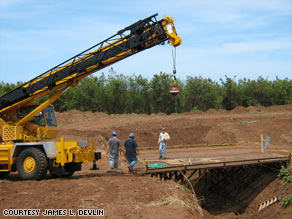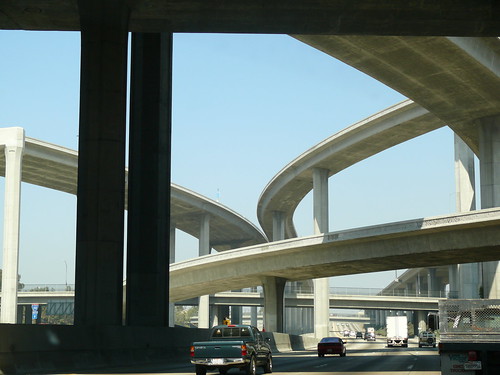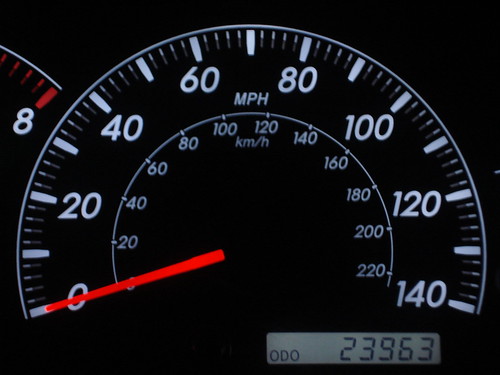President Obama, Vice President Biden, Transportation Secretary LaHood Announce 2,000th Transportation Project Under Economic Recovery Act
(Source: USDOT Press Release)
President Barack Obama today announced funding for the 2,000th transportation project under the American Recovery and Reinvestment Act (ARRA), only six weeks after approving the first project. The President made the remarks at the U.S. Department of Transportation with Vice President Biden and Transportation Secretary Ray LaHood.
“Just 41 days ago we announced funding for the first transportation project under ARRA and today we’re approving the 2,000thproject,” said President Obama. “I am proud to utter the two rarest phrases in the English language – projects are being approved ahead of schedule, and they are coming in under budget.”
“The Recovery Act is being implemented with speed, transparency and accountability,” said Vice President Biden. “Don’t take my word for it – just look at what’s happening today. We have the 2000th transportation project now underway – that’s going to help create jobs, make it easier for folks to get to the jobs they have, and improve our nation’s infrastructure all at the same time. The Recovery Act is full- steam ahead on helping us build an economy for the 21st century.”
“This is the government working for the people, creating jobs today and laying the foundation for a bright economic future,” said Secretary LaHood.
The 2,000th project is in Kalamazoo County, Michigan. The $68 million project involves widening of I-94 from two lanes both east and westbound to three lanes in each direction. The project will improve safety and ease congestion by providing a more efficient interchange.
State departments of transportation around the country have reported to FHWA intense competition by contractors for ARRA projects. Bids have been roughly 15 to 20 percent lower on average, and as much as 30 percent lower in some cases, than engineers anticipated. For example, in Colorado, the state’s first five ARRA transportation projects announced on April 2 were 12 percent lower than anticipated. In Maine, one bridge project was 20 percent lower than estimated. In Oregon, during February and March 2009, bids have averaged 30 percent lower than expected.
President Obama secured passage of the ARRA and signed it into law on February 17, less than one month after taking office. Less than two weeks later, on March 3, the President, Vice President Biden and Secretary LaHood released the first funding to the states and localities for highways, roads and bridge projects. That release of funds came eight days earlier than required by law.
ARRA provides a total of $48.1 billion for transportation infrastructure projects to be administered by the U.S. Department of Transportation. Of that $27.5 billion is for highways and bridges, $8.4 billion is for transit, $8 billion is for high speed rail, $1.3 billion is for Amtrak, $1.5 billion is for discretionary infrastructure grants $1.3 billion is for airports and Federal Aviation Administration facilities and equipment and $100 million for shipyards.
In early February, prior to the passage of the ARRA, Secretary LaHood established within the U.S. Department of Transportation the TIGER (Transportation Investments Generating Economic Recovery) team to ensure that economic recovery dollars for transportation infrastructure projects is rapidly made available and that project spending is monitored and transparent. On March 3, the President unveiled a TIGER logo, as well as an ARRA logo, that will be placed on construction signs across the country, to mark projects being built and jobs created with Recovery Act funds.
—————————————————————————————————————————-
Due to heightened competition among contractors for recovery construction work, Transportation agencies across the nation are receiving project bids substantially lower than engineers’ initial estimates. These lower than expected bids are allowing states to stretch economic recovery funds to pay for additional projects, which the Department of Transportation predicts will create even more jobs and yield further infrastructure repair nationwide. Below is a sampling of state transportation projects set to break ground across the country at a fraction of initial estimates.
“At Baltimore-Washington International Marshall Airport, a recent project to reconstruct the area around Piers C and D received six bids instead of the usual two or three. The result: The estimated $50 million project will be built for $8 million less than was budgeted, and the savings will be allocated to other projects. There were 21 bidders for a $200,000 drainage project in Carroll County, more than anyone could remember.” [Washington Post, 4/8/09]
Click here to read the entire presser.







 The traffic stimulus measure is touted as helping revive highway travel which is down about 4%, and to revive associated spending on gasoline and diesel fuels, car service, hotels, new cars and electronics. However it is also obviously influenced by lobbying and PM Aso’s desire for public acclaim.
The traffic stimulus measure is touted as helping revive highway travel which is down about 4%, and to revive associated spending on gasoline and diesel fuels, car service, hotels, new cars and electronics. However it is also obviously influenced by lobbying and PM Aso’s desire for public acclaim. 
 The discounts range in size. Some Tokyo metro area tolls are only discounted at night 10pm to 6am, some Sundays and holidays.
The discounts range in size. Some Tokyo metro area tolls are only discounted at night 10pm to 6am, some Sundays and holidays.
